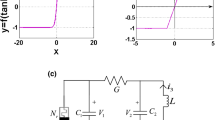Abstract
In this paper, a state-controlled cellular neural network (SC-CNN)-based hyperchaotic circuit is implemented for classical modified canonical Chua’s circuit. The proposed system is modeled by using a suitable connection of four state-controlled generalized CNN cells, while the stability of the circuit is studied by determining the eigenvalues of the stability matrices, the system parameter is varied, and the dynamics as well as the onset of chaos and hyperchaos followed by a period-three doubling bifurcation has been studied through numerical analysis of the generalized SC-CNN equations and real-time experiments. We further validate our findings, the chaotic and hyperchaotic dynamics, characterized by two positive Lyapunov exponents and Lyapunov dimension, is described by a set of four coupled first-order generalized SC-CNN equations. This has been investigated extensively not only analyzing by computer simulation but also demonstrating by laboratory experiments. The experimental results such as phase portraits, Poincaré surface sections and power spectra are in good agreement with those of numerical computations.












Similar content being viewed by others
References
Peng, J.H., Ding, E.J., Ding, M., Yang, W.: Synchronizing hyperchaos with a scalar transmitted signal. Phys. Rev. Lett. 76, 904–907 (1996)
Tamaševičius, A., Namajunas, A., Čenys, A.: Simple 4D chaotic oscillator. Electron. Lett. 32, 957–958 (1996b)
Tamaševičius, A., Čenys, A., Mykolaitis, G., Namajunas, A., Lindberg, E.: Hyperchaotic oscillator with gyraiors. Electron. Lett. 33, 542–544 (1997)
Blakely, J.N., Gauthier, D.J.: Attractor bubbling in coupled hyperchaotic oscillators. Int. J. Bifurcat. Chaos 10, 835–847 (2000)
Thamilmaran, K., Lakshmanan, M., Venkatesan, A.: Hyperchaos in a modified canonical Chua’s circuit. Int. J. Bifurcat. Chaos 14, 221–243 (2004)
Röossler, O.E.: An equation for hyperchaos. Phys. Lett. A 71, 155–157 (1979)
Matsumoto, T., Chua, L.O., Kobayashi, K.: Hyperchaos: laboratory experiment and numerical confirmation. IEEE Trans. Circuits Syst. 33, 1143–1147 (1986)
Mitsubori, K., Saito, T.: A four dimensional plus hysteresis chaos generator. IEEE Trans. Circuits Syst. I 41, 782–789 (1994)
Saito, T.: The dead-zone conductor hyperchaos generator. Electron. Commun. Jpn. 72, 58–67 (1990)
Stoop, R., Peinke, J., Parisi, J., Rohricht, B., Huebener, R.P.: A p-Gesemiconductor experiment showing chaos and hyperchaos. Physica D 35, 425–435 (1989)
Kapitanik, T., Chua, L.O.: Hyperchaotic attractor of unidirectionally-coupled Chua’s circuits. Int. J. Bifurcat. Chaos 4, 477–482 (1994)
Kapitaniak, T., Chua, L.O., Zhong, G.O.: Experimental hyperchaos in coupled Chua’s circuits. IEEE Trans. Circuits Syst. I 41(41), 499–503 (1994)
Kaneko, K.: Doubling of Torus. Prog. Theor. Phys. 69, 1806–1810 (1983)
Harrison, M.A., Lai, Y.C.: Route to highdimensional cahos. Phys. Rev. E 59, R3799–R3802 (1999)
Kapitaniak, T., Maistrenko, Y., Popovych, S.: Chaos-hyperchaos transition. Phys. Rev. E 62, 1972–1976 (2000)
Li, G.N., Chen, X.Y.: Study on eigenvalue space of hyperchaotic canonical four-dimensional Chua’s circuit. Chin. Phys. B 19, 030507 (2010)
Ishaq Ahamed, A., Lakshmanan, M.: Nonsmooth bifurcations, transient hyperchaos and hyperchaotic beats in a memristive Murali-Lakshmanan- Chua circuit. Int. J. Bifurcat. Chaos 23, 1350098 (2013)
Chua, L.O., Yang, L.: Cellular neural networks: theory. IEEE Trans. Circuits Syst. 35, 1257–1272 (1988)
Arena, P., Baglio, S., Fortuna, L., Manganaro, G.: Chua’s circuit can be generated by CNN cells. IEEE Trans. Circuits Syst. I 42, 123–125 (1995)
Gunay, E.: MLC circuit in the frame of CNN. Int. J. Bifurcat. Chaos 20, 3267–3274 (2010)
Gunay, E.: A new autonomous chaos generator from state controlled Cellular Neural Networks. Int. J. Bifurcat. Chaos 22, 1250069 (2012)
Kilic, R.: SC-CNN based multifunction signal generator. Int. J. Bifurcat. Chaos 17, 4387–4393 (2007)
Kilic, R., Alci, M.: A SC-CNN based chaotic masking system with feedback. Int. J. Bifurcat. Chaos 14, 245–256 (2004)
Arena, P., Baglio, S., Fortuna, L., Manganaro, G.: Hyperchaos from cellular neural networks. Electron. Lett. 31, 250–251 (1995)
Caponetto, R., Fortuna, L., Occhipinti, L., Xibilia, M.G.: Hyperchaotic dynamic generation via SC-CNNs for secure transmission applications. IEEE Conf. Proc. 1, 492–496 (1998)
Cafagna, D., Grassi, G.: Two-cell cellular neural networks: generation of new hyperchaotic multiscroll attractors. IEEE Conf. Proc. 2, 924–929 (2003)
Yang, X.-S., Yang, F.: Chaos and hyperchaos in a class of simple cellular neural networks modeled by O.D.E. Int. J. Bifurcat. Chaos 16, 2729–2736 (2006)
Swathy, P.S., Thamilmaran, K.: An experimental study on SC-CNN based canonical Chua’s Circuit. Nonlinear Dyn. 71, 505–514 (2013)
Chua, L.O., Lin, G.: Canonical realization of Chua’s circuit family. IEEE Trans. Circuits Syst. 37, 885–902 (1990)
Kyprianidis, I.M., Petrani, M.L., Kalomiros, J.A., Anagnostopoulos, A.N.: Crisis-induced intermittency in a third-order electrical circuit. Phys. Rev. E 52, 2268–2273 (1995)
Wu, C.W., Rulkòv, N.F.: Studying chaos via 1-D maps-A tutorial. IEEE Trans. Circuits Syst. I 40, 707–721 (1993)
Banerjee, S., Grebogi, C.: Border collision bifurcations in two-dimensional piecewise smooth maps. Phys Rev. E 59, 4052–4061 (1999)
Wolf, A., Swift, J.B., Swinney, H.L., Vastano, J.A.: Determining Lyapunov exponents from a time series. Physica D 16, 285–317 (1985)
Wu, X.P., Wang, L.: Co-dimension-2 bifurcation of coupled BVP oscillators with hard characteristics. Appl. Math. Comput. 219, 5303–5320 (2013)
Acknowledgments
PSS acknowledges the University Grants Commission (UGC) for the financial assistance through RFSMS scheme. KT acknowledges DST, Govt. of India for the financial support through the Grant No. SR/S2/HEP-015/2010.
Author information
Authors and Affiliations
Corresponding author
Rights and permissions
About this article
Cite this article
Swathy, P.S., Thamilmaran, K. Hyperchaos in SC-CNN based modified canonical Chua’s circuit. Nonlinear Dyn 78, 2639–2650 (2014). https://doi.org/10.1007/s11071-014-1615-7
Received:
Accepted:
Published:
Issue Date:
DOI: https://doi.org/10.1007/s11071-014-1615-7




